
TRT Podcast #91: The 3 important parts of an explicit lesson
091: Learn the structure of an explicit lesson, and get a free template in the show notes!
Listen to the episode here
Full episode transcript
Hello! Anna Geiger here from The Measured Mom for Episode 91 of the Triple R Teaching podcast. This week we are going to look at explicit instruction. Last week we talked about what it is, and today we're going to look at the structure of an explicit lesson.
I talked last week about how, to me, in the past, explicit instruction sounded boring. It sounded like it had to be scripted, and that it was just the teacher talking at the students. Drill and kill. But now I understand that explicit instruction is actually proven by research to be most effective in teaching students academic skills. It's also been shown to be most effective at improving students self-confidence and self-esteem because, as Anita Archer likes to say, success breeds motivation.
If you want to know more about that research, go ahead and check out Project Follow Through, which I will link to in the show notes.
As I mentioned last week, if you really want to know about explicit instruction and the ins and outs of it, I would recommend checking out Anita Archer. She is the queen of explicit instruction, has been in education for decades, and has produced many wonderful workshops and online trainings, and especially her book "Explicit Instruction," which she co-wrote with Charles Hughes. Anytime you're wondering about explicit instruction, you can be sure to learn something when you find Dr. Archer. Today a lot of what I'm sharing is from her book "Explicit Instruction."
When we think about an explicit lesson, we think about three parts. We want to have the opening, the body, and the conclusion. Of course, most of what you're doing is going to be happening in the body of the lesson, but it's important to set it up well.
To start your lesson, you want to have a routine where you get your students' attention. Now, as a teacher, I wish I would've done this, I think it would've saved a lot of transition time and a lot of headaches. It's something you want to teach at the beginning of the year, or the middle of the year if that's when you're going to implement this.
There are many ways to do this. A lot of teachers like to do something called call and response. That's where you say the same thing always, and your students respond the same each time. For example, "One, two," and the students respond, "Eyes on you!" Or the teacher says, "Eyes," and the students say, "Open!," the teacher says, "Ears," and they respond, "Listening!" or something like that. I will go ahead and link to some different call and response ideas in the show notes for this episode so you can pick one, if you're not already doing this, that will work to get your students' attention at the beginning of every lesson that you give.
Once you've gotten their attention, you want to tell them what it is you're going to teach them that day. So maybe you would say, "Today, we're going to learn how to spell the /sh/ sound with S-H." And then, if necessary, you can talk about how this is relevant, and why this is important to know.
Then you're going to move into the body of the lesson, and that's where you want to follow the, I do, we do, you do model. I was recently listening to something by Dr. Archer and she mentioned having coined this phrase, so if I heard that correctly, she's the one who came up with this, probably a long time ago, because like I said, she's been in education for decades.
According to Dr. Archer, the "I do it" is my turn, "we do it" is let's do this together, and "you do it" is your turn. I think that a lot of us assume we're kind of doing this in our lessons automatically, but then if we would actually look closely at our lessons, we would find out, "Oh, actually I'm not really doing that," because that's probably what I would've thought. Then if I would've looked at it closely, I would've seen, "Oh, I jumped right to the we do it. Or for the I do it, I really wasn't very explicit, and I didn't explain it very well."
It's a good practice to think through some of your lessons before you give them with this in mind. I'll provide a free template in the show notes so you can try that for a few lessons just to make sure this is really what you're doing.
So with the "I do it," you're going to model the new skill. Going back to the SH, I could show a card and I say, "These are the letters SH. SH spells /sh/. Here are some words with SH. Watch as I blend the sounds together to read the words." The maybe I would have the word "ship" so that all the students could see it, and I would probably underline the SH as I read it to show them that this makes one sound, "/sh/-/ĭ/-/p/, ship." Then there's another word, maybe "shed," and then I would, again, underline it. "Watch me blend the sounds, /sh/-/ĕ/-/d/, shed." Then I could do some with the SH at the end of the word.
Then I could also model spelling words with SH. "I'm going to spell the word 'shut,' as in 'I shut the door.' The sounds of shut are /sh-/ŭ/-/t/. I'm going to draw three lines and I'm going to spell each sound in a line. So the first sound is /sh/. All right I know that S-H spells /sh/ that goes in my first blank," and so on. After you've done the modeling during which you are engaging your students, it's not just you talking to them, there's going to be some back and forth.
Then you're going to go to the "we do it" where you do these things with them. This might be a set of blending lines, I've written a blog post about that and I'll link to it in the show notes. These start simply. On the top, the first line, the words could be in pairs that differ by just a single phoneme, we call those minimal pairs. So you could have a word like "ship" and "shop" only one phoneme changes, the vowel. Then as you go on, they get more complicated. So then you could have a line of words that have SH in them, but all the vowels are different. The idea is to start simple and move to more complex, but you do those with your students to start. You show them, you point to each sound spelling and have them kind of think it through in their heads, and then altogether they say the word. You could also do dictation together where you dictate a word, but together you spell the sounds. So that's the "we do it" part.
Then, of course, "you do it" is when they get a chance to try this out on their own. Now let's say you're doing an explicit phonics lesson, a small group lesson just like I talked about with the SH, and the lesson is done and you want them to do this on their own. I would recommend doing some kind of decodable book work, where they have to read the words themselves, or maybe reading a list of words, or also doing dictation.
Now just to be clear, if you're teaching a very complex topic the "I do, we do, you do" may not occur all at once. You may spread those out over several days, but they're all included as you're teaching this new skill.
The closing of the lesson is very brief. You're just going to review what you taught your students, and then you may set them free for independent work. So if you are doing that SH lesson in a small group, you might send your students off to centers and have the first activity that they do be a worksheet or more reading of words that have the SH in them.
Normally, of course, your centers need to be review from previously-learned skills, but you may have just one be always a continuation of independent work from that new skill that they learned.
As a review, an explicit lesson should have three parts: the opening, the body, and the closing.
In the opening, you're getting their attention. You're stating the goal of the lesson. Something I forgot to mention at the beginning, sorry about that, is that you want to include review of critical prerequisite skills. That's anything they have to know to understand this new skill, and you're not sure how well they know it, make sure you review it at the beginning of your lesson.
Then, of course, in the body, you're going to be modeling it. Then you're going to have them do it with you with scaffolding and prompting. And then, finally, they're going to do it on their own with you watching.
Finally the closing, you're going to review what they learned, and then you're going to assign independent work.
Again, I will provide a free template in the show notes so you can try this out and see if you're really doing this already and how you could improve the structure of your lessons for the future. You can find the show notes at themeasuredmom.com/episode91. See you next week!
Sign up to receive email updates
Enter your name and email address below and I'll send you periodic updates about the podcast.
Related links
- Explicit Instruction, by Anita L. Archer and Charles A. Hughes
- Why Explicit Instruction? video with Anita Archer on Center for Dyslexia MTSU
- Project Follow Through
- 50 fun call and response ideas
- How to use blending lines (with free editable template)








Leave a Comment